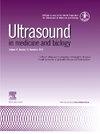子痫前期大鼠模型胎盘组织微观结构的定量超声表征。
IF 2.6
3区 医学
Q2 ACOUSTICS
引用次数: 0
摘要
目的:应用定量超声(QUS)方法检测子痫前期大鼠子宫灌注压降低(RUPP)模型中胎盘微结构的变化。子痫前期是一种危及生命的妊娠疾病,与胎盘发育异常有关,治疗和管理不充分。方法:选取9只妊娠期Sprague-Dawley大鼠。妊娠第14天(GD 14), 5只大鼠行RUPP手术诱导子痫前期。获取美国射频数据用于GD18的QUS分析。在GD19上,动物被处死并解剖以获得胎盘组织样本。测量胎盘各解剖层的细胞核直径,与区域有效散射体直径(ESD)值进行比较。结果:体内QUS成像获得的ESD测量值与显微镜图像获得的细胞核直径测量值具有良好的相关性(R2 = 0.58, p = 3.8e-6)。与对照组胎盘相比,RUPP胎盘的连接区明显较小(p = 0.013)。RUPP胎盘的平均ESD比对照组胎盘小1.0µm (p = 0.040)。RUPP胎盘中ESD的降低与连接区大小的减小相一致,与迷路区和绒毛板相比,连接区细胞核更大(p = 3.3e-21和p = 9.5e-27), ESD更大(p = 5.6e-4和p = 4.5e-8)。结论:这些结果表明,QUS作为一种非侵入性工具,可以检测胎盘微观结构的关键变化,通过早期诊断和更及时的治疗干预,改善母婴结局。本文章由计算机程序翻译,如有差异,请以英文原文为准。

Quantitative Ultrasound-Based Characterization of Placental Tissue Microstructure in a Rat Model of Preeclampsia
Objective
Quantitative ultrasound (QUS) methods were applied to detect changes in placental microstructure in the reduced uterine perfusion pressure (RUPP) model of preeclampsia in rats. Preeclampsia is a life-threatening pregnancy disorder associated with abnormal placental development that is inadequately treated and managed.
Methods
Nine timed-pregnant Sprague–Dawley rats were used in this study. On gestational day 14 (GD 14), five rats received RUPP surgery to induce preeclampsia. US radiofrequency data were acquired for QUS analysis on GD18. On GD19, animals were sacrificed and dissected to acquire placental tissue samples. The cell nuclear diameter in each anatomical layer of the placenta was measured to compare with regional effective scatterer diameter (ESD) values.
Results
ESD measurements obtained using in vivo QUS imaging correlated well (R2 = 0.58, p = 3.8e–6) with cell nucleus diameter measurements from microscopy images. RUPP placentas had significantly smaller junctional zones compared to control placentas (p = 0.013). The average ESD in RUPP placentas was 1.0 µm smaller compared to control placentas (p = 0.040). This decrease in ESD in RUPP placentas is consistent with the decreased size of the junctional zone, which, in comparison to the labyrinth zone and chorionic plate, has larger cell nuclei (p = 3.3e–21 and p = 9.5e–27, respectively) and larger ESD (p = 5.6e–4 and p = 4.5e–8, respectively).
Conclusion
These results demonstrate the potential of QUS as a non-invasive tool for detecting critical changes in placental microstructure, improving maternal and fetal outcomes by enabling earlier diagnosis and more timely therapeutic interventions in preeclampsia.
求助全文
通过发布文献求助,成功后即可免费获取论文全文。
去求助
来源期刊
CiteScore
6.20
自引率
6.90%
发文量
325
审稿时长
70 days
期刊介绍:
Ultrasound in Medicine and Biology is the official journal of the World Federation for Ultrasound in Medicine and Biology. The journal publishes original contributions that demonstrate a novel application of an existing ultrasound technology in clinical diagnostic, interventional and therapeutic applications, new and improved clinical techniques, the physics, engineering and technology of ultrasound in medicine and biology, and the interactions between ultrasound and biological systems, including bioeffects. Papers that simply utilize standard diagnostic ultrasound as a measuring tool will be considered out of scope. Extended critical reviews of subjects of contemporary interest in the field are also published, in addition to occasional editorial articles, clinical and technical notes, book reviews, letters to the editor and a calendar of forthcoming meetings. It is the aim of the journal fully to meet the information and publication requirements of the clinicians, scientists, engineers and other professionals who constitute the biomedical ultrasonic community.

 求助内容:
求助内容: 应助结果提醒方式:
应助结果提醒方式:


